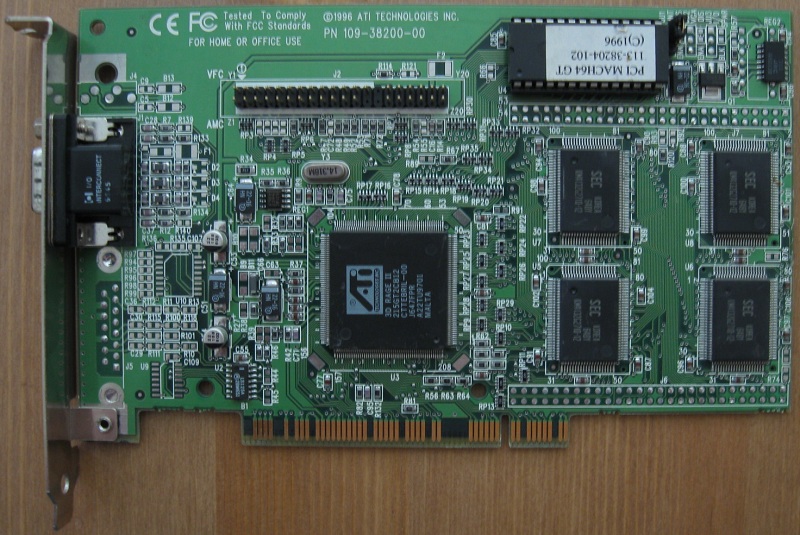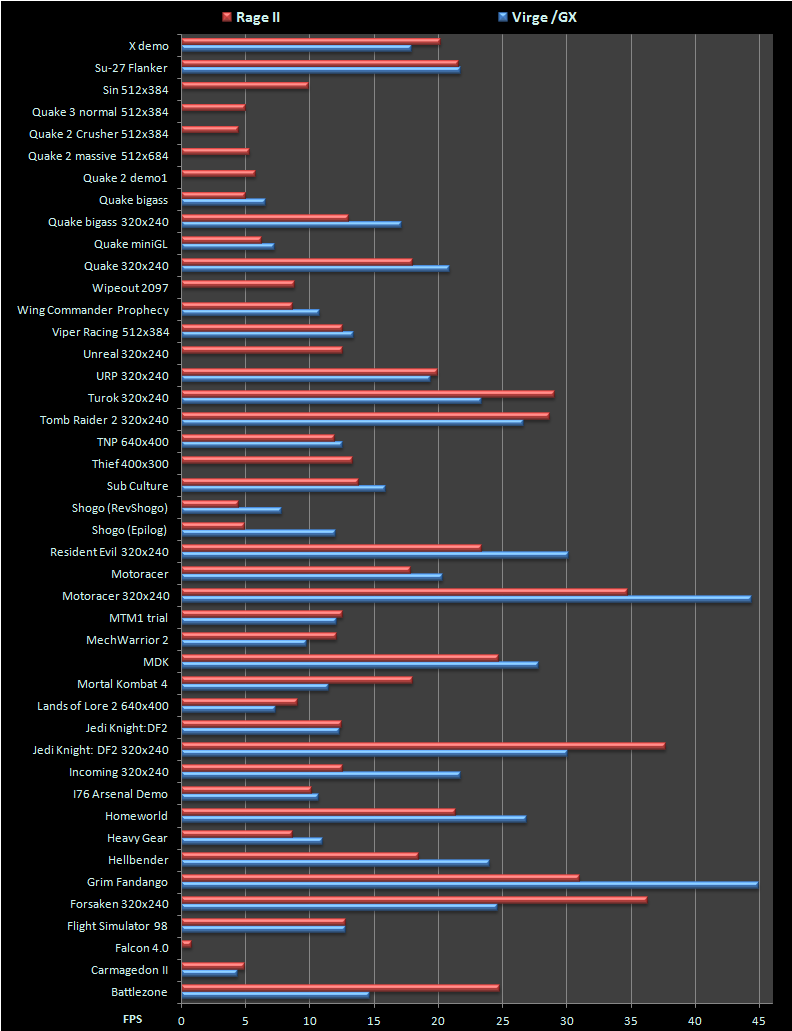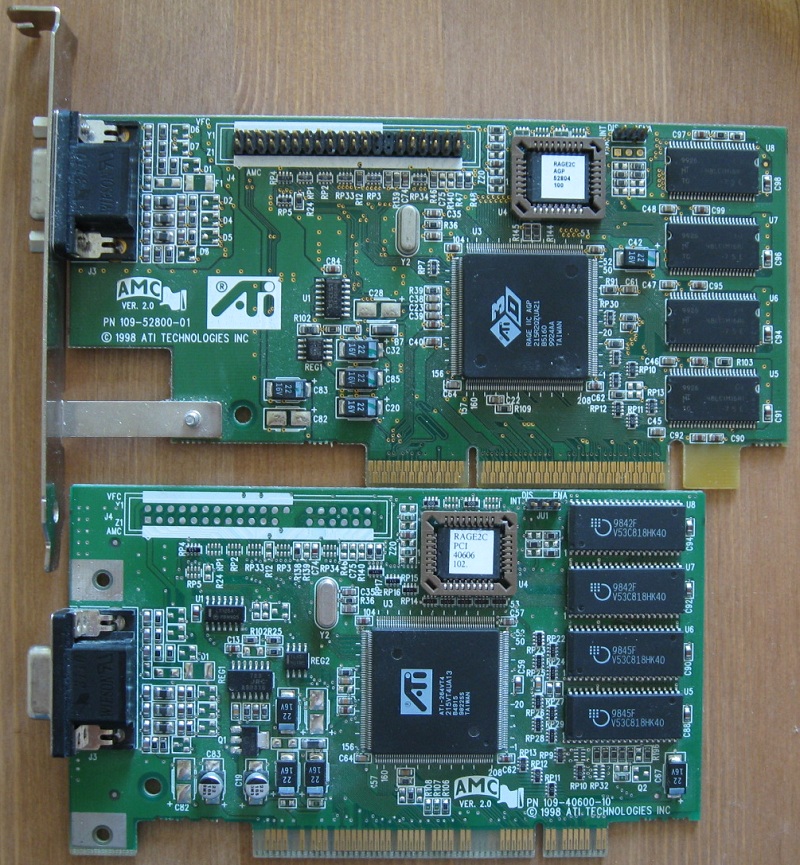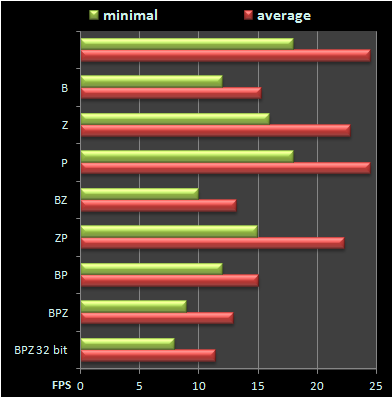Again and better
Autumn 1996 came and before anyone could yet realize first Rage will have miserable Direct3D compatibility, ATI unveiled second chip of the line. This time the architecture was definitely up to date with all of the critical 3d features working. And ATI did not sacrifice any of it's other goodies, in fact redesigned the Mach64 core and adds hardware MPEG2 playback. 48-level command FIFO should help throughoutput. All 3d primitives from points to quadrilaterals are supported. Announced performance was 26 million perspectively correct texture mapped pixels per second. Considering full availability in Christmas season such figure was far from exciting. More promising feature could be texture compression technique with two to four times compression ratio, but by this ATi understood less exciting palletized textures. Considering how many boards shipped with only two megabytes of memory, it is welcome addition nonetheless. Most important was z-buffering implemented in hardware, as it became requirement for many Direct3D games. Cards with original Rage II chip were usually named 3D Xpression+.
Rage II in person
 I bought this board with four memory chips in hope it is 4 MB, but it seems only way to get first Rage II with such capacity is through cards with memory expansion module. This will limit number of tests but never mind, better to have casual card than rarely used exception. There should be also 3D PRO TURBO PC2TV with 4 MB onboard which could with expansion reach the maximum of 8 MB but good luck finding that. My clocking tools detects single frequency of 68 MHz, which should be memory clock since ATI's performance figures suggest 52 MHz chips clock or 56 for PC2TV. With 4:5 ratio, same as first Rage, my card could have realistic 54/68 MHz clocks. Driver selected VT3 string for the card, which is interesting. As far as I could search, VT3 was a solution integrated to motherboards. This is not so surprising, we are in the years when ATi's offerings were at it's most confusing and clocks were not set in stone.
I bought this board with four memory chips in hope it is 4 MB, but it seems only way to get first Rage II with such capacity is through cards with memory expansion module. This will limit number of tests but never mind, better to have casual card than rarely used exception. There should be also 3D PRO TURBO PC2TV with 4 MB onboard which could with expansion reach the maximum of 8 MB but good luck finding that. My clocking tools detects single frequency of 68 MHz, which should be memory clock since ATI's performance figures suggest 52 MHz chips clock or 56 for PC2TV. With 4:5 ratio, same as first Rage, my card could have realistic 54/68 MHz clocks. Driver selected VT3 string for the card, which is interesting. As far as I could search, VT3 was a solution integrated to motherboards. This is not so surprising, we are in the years when ATi's offerings were at it's most confusing and clocks were not set in stone.
Experience
3d gaming with mere 2 MB is very limiting even if the chip was powerful. And Rage II ain't some speedster. For it's time it is quite feature rich and can draw nice pictures, unless one nasty bug kicks in. Similarly to Laguna3D all members of Rage II family suffers from perspective problems, some surfaces are just wavy instead of straight. There are tweakers with sliders that should help with this issue sacrificing some performance, but I couldn't achieve any change. Maybe newer drivers broke compatibility with the tweak. As for driver bugs, I found only one serious, objects are disappearing in Battlezone. Not because of lack of memory, this happens for all Rage II cards reviewed. Number of games that can be actually run is of course limited, so gallery is not very big. There is one suspicious image quality issue, textures often seem to have reduced color range. Yet the driver is not preferring 5550 format, there is no speed improvement anyway. Needless to say 32 bit frame-buffer color with so little memory, even if well implemented, is out of question. Blending unit looks flexible enough for any mode early Direct3d apps could throw at it. Only vertex fogging is performed rather slowly and often incompatible with transparent surfaces.

S3's Virge /GX was released around same time and it pretty much equals Rage II in average framerate. In minimal fps however Rage II takes some 20% lead and I have no doubt it would eclipsed the Virge if it had 4 MB of memory as well.
Adding the plus

Experience
 As you will see in the performance summary improvements in the 3d architecture are not to be seen in real games. Come to think of it how many small triangles were in old games? Thus the improvement over first Rage II comes down only to more memory. For 3D Charger 4 MB of memory became standard and the card has good compatibility, avoiding problems until new generations of games in 1998. Same features, same image quality, as can be seen in the gallery.
Upon closer look the bilinear filter is really cheap, just like first Rage showed. This creates obvious color banding on low resolution textures viewed up close. ATI kept filtering corners cutted with Rage II family as well. This is not much of surprise from a chip without texture caching, still despite this optimization in synthetic tests the performance drop of bilinear filtering remains rather big.
As you will see in the performance summary improvements in the 3d architecture are not to be seen in real games. Come to think of it how many small triangles were in old games? Thus the improvement over first Rage II comes down only to more memory. For 3D Charger 4 MB of memory became standard and the card has good compatibility, avoiding problems until new generations of games in 1998. Same features, same image quality, as can be seen in the gallery.
Upon closer look the bilinear filter is really cheap, just like first Rage showed. This creates obvious color banding on low resolution textures viewed up close. ATI kept filtering corners cutted with Rage II family as well. This is not much of surprise from a chip without texture caching, still despite this optimization in synthetic tests the performance drop of bilinear filtering remains rather big.

Complementing Rage Pro

Experience
 Rage II+ top, Rage IIc down- It takes more than 4MB for highest textures and framerate does not suffer.
Rage II+ top, Rage IIc down- It takes more than 4MB for highest textures and framerate does not suffer.
Regarding 3d gaming VT4 is just another Rage II card and Rage IIc is not so fast to benefit from AGP and 8 MB will help only in extreme cases like Falcon 4.0. So I have nothing much to talk about, gallery is at your disposal anyway.

None of the advantages of my Rage IIc can help it challenge any high performance architecture, so I put it against the last Virge in disguise. ATI is doing a bit better with a 7% average and 14% minimal fps advantage. All my Rage II cards are solid overclockers, but with this mature Rage IIc card with 7ns memory, I was hoping for some great results. It turned out that R2c has the same memory clock wall as R3- after 118 MHz it gives up. Rage IIc also seems to be the only R2 chip with a fully asynchronous chip and memory frequency.
Overall
 While ATI had a horrible Windows driver reputation since Mach64, and the packages have a scary amount of files, my test system was stable and everything went as it should. It took many years but the final drivers are definitely suitable. On the hardware side Rage II was a solid low-end architecture, but still with insufficient fillrates for 640x480 and therefore in a great distance of performance chips. 400x300 is where it is at, ATi tied Rendition's V1000 and added extra video goodies. It scored with an imperfect, but well-chosen feature set including all important blending modes. Only after games like Half-Life or Unreal went by the Rage II would fail to render something really important. However, some bugs and simplifications hold image quality back. With memory bandwidth and sufficient capacity to allocate, true color rendering is a possibility. I did some feature tests on VT4 in Tomb Raider 2. Perspective correction, 32-bit depth, and even Z-buffering have little impact. But bilinear filtering has a higher than desirable performance drop and adding the other features on top of that is even more of a burden. Even if these features were "free", Rage II performance would be far from the best. The texture mapping is just slow, unable to show better rates than three clocks per sample, even in the simplest of scenarios. Also, the depth buffer never delivered improved performance, so it is unlikely there is any z-compare rejection of pixels. But for the time Rage II line gained a big market share among 3d accelerators. With the advent of new generation of low-end chips like SiS 6326 advantages of Rage II were gone. It was up to Rage Pro to move ATi into higher class 3d gaming.
While ATI had a horrible Windows driver reputation since Mach64, and the packages have a scary amount of files, my test system was stable and everything went as it should. It took many years but the final drivers are definitely suitable. On the hardware side Rage II was a solid low-end architecture, but still with insufficient fillrates for 640x480 and therefore in a great distance of performance chips. 400x300 is where it is at, ATi tied Rendition's V1000 and added extra video goodies. It scored with an imperfect, but well-chosen feature set including all important blending modes. Only after games like Half-Life or Unreal went by the Rage II would fail to render something really important. However, some bugs and simplifications hold image quality back. With memory bandwidth and sufficient capacity to allocate, true color rendering is a possibility. I did some feature tests on VT4 in Tomb Raider 2. Perspective correction, 32-bit depth, and even Z-buffering have little impact. But bilinear filtering has a higher than desirable performance drop and adding the other features on top of that is even more of a burden. Even if these features were "free", Rage II performance would be far from the best. The texture mapping is just slow, unable to show better rates than three clocks per sample, even in the simplest of scenarios. Also, the depth buffer never delivered improved performance, so it is unlikely there is any z-compare rejection of pixels. But for the time Rage II line gained a big market share among 3d accelerators. With the advent of new generation of low-end chips like SiS 6326 advantages of Rage II were gone. It was up to Rage Pro to move ATi into higher class 3d gaming.